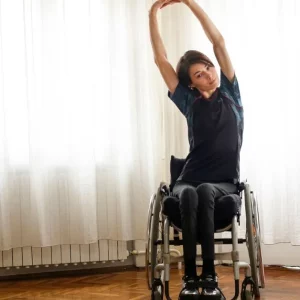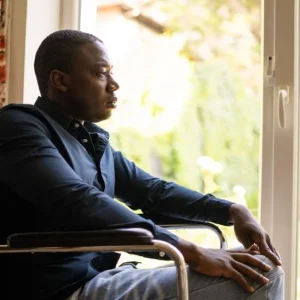Spinal cord injury in children can have significant effects on their mobility and sensation. However, children often are able to recover more quickly from spinal cord injuries than adults.
Children’s bodies heal faster than adults because they’re still developing. Their bones, muscles, and organs are continuously working towards growing, getting stronger, and functioning more efficiently.
However, their bodies are also more fragile, so a spinal cord injury (SCI) may cause more complications in children than adults.
In this article, we’ll go over what differentiates spinal cord injury in children and the best ways to promote recovery.
How Common is Spinal Cord Injury in Children?
Children make up only a small portion of all reported spinal cord injuries.
According to the National Spinal Cord Injury Statistical Center’s 2020 Report, less than 1% of 34,733 individuals with SCI were children age 12 or younger. Most injuries in this age group are caused by car accidents and falls.
However, SCIs become more common as children transition into adolescence. From the same report, nearly 8% of individuals with spinal cord injury were 13-17 years old. Teens are more likely to get SCIs from driving cars, playing sports, and engaging in reckless behavior. Younger children are less likely to engage in these activities, thus are less likely to sustain a spinal cord injury.
Children most often sustain higher level SCIs (frequently in the cervical spine, which is the neck region of the spinal column). Additionally, young children are more likely to have complete spinal cord injuries, meaning that there is no communication between the brain and nerves below the level of injury.
While spinal cord injuries are relatively rare in infants and toddlers, many could be prevented by using appropriate car seat safety techniques. The American Academy of Pediatrics changed their guidelines in 2018 to recommend a using a rear-facing car seat for as long as possible, until the child meets the seat’s height or weight specifications (usually around 40 lbs).
Infants and toddlers are more likely to sustain a cervical spinal cord injury during a car accident if they are forward-facing rather than rear-facing. This is because young children have looser ligaments in their spines and relatively large heads in proportion to their bodies. If they are properly buckled into a rear-facing car seat, the neck and spine are more protected during a car accident, reducing the risk of injury.
How Does Spinal Cord Injury Affect Children Differently Than Adults?
Because children are constantly growing and developing, spinal cord injuries will affect their bodies differently than adults.
Specifically, children with SCIs have an increased risk of developing scoliosis and pressure sores.
Scoliosis
Scoliosis occurs when the spine develops a curve to the side.
According to the American Spinal Injury Association, more than 90% of children who sustain a spinal cord injury before puberty develop scoliosis.
Similar to adults, children who have higher level injuries resulting in paralysis of their trunk muscles often struggle to sit upright and may start leaning to the side.
Scoliosis doesn’t develop immediately, but it can be caused by consistently compromised posture. Because children’s bodies and muscles are still growing, they are at higher risk for developing scoliosis than adults with SCI.
Pressure Sores
Children also have much thinner skin than adults. As a result, it is very easy for them to develop pressure sores.
Pressure sores occur when you sit or lay in the same position for too long. The prolonged pressure cuts off blood flow and tissues start to die, which causes skin to break down.
Pressure sores are common after SCI because impaired sensation eliminates feelings of restlessness that urge us to change positions in order to reduce pressure in one spot.
Diagnosing Spinal Cord Injury in Children

It can be difficult to diagnose spinal cord injuries in children. Since children have extremely elastic ligaments, their spine can extend without notable signs of fracture.
A young spinal column can stretch up to 5cm further than the spinal cord. Even though the spinal column may not be affected, the spinal cord can still become damaged. In these cases, SCIs won’t be visible using standard imaging, such as an x-ray or CT scan. This occurs in approximately 20% of all pediatric SCIs, and is called spinal cord injury without radiographic activity (SCIWORA).
Frequently, an MRI may show evidence of an SCI if standard imaging does not. However, an SCI may not be visible even using an MRI in up to 65% of young children displaying symptoms.
The onset of neurological symptoms, such as changes in sensation and paralysis, can take up to four days to occur in children with SCI, further complicating their diagnosis.
Therefore, it’s essential to work with pediatric therapists that understand these challenges and can effectively communicate with your child for optimal recovery.
Recovery for Children with SCI

Recovery from a spinal cord injury (if it is an incomplete injury) is typically quicker for children than it is for adults because they have higher levels of neuroplasticity.
Neuroplasticity is the central nervous system’s ability to rewire itself. By stimulating the spinal cord with repetitive movement, functions weakened by SCI can likely be recovered.
The more repetitions you perform, the more you’ll promote neurological adaptations in the spinal cord. Because children have more neuroplasticity, fewer repetitions are required to recover functions.
Treatments for spinal cord injury in children include:
- Physical therapy. Focuses on increasing mobility and strength through stretching, manual therapy, and exercises.
- Occupational therapy. Addresses difficulties with participating in daily activities through rehabilitation and compensatory strategies.
- Speech therapy. Works on improving breathing, speech, and eating challenges in children with higher level injuries.
Therapists will often use games and fun activities during their treatments to promote optimal engagement. When children are engaged in their recovery, they are often more motivated to complete the repetitions needed for neuroplasticity.
Many therapists will also encourage children to participate in a home exercise program for a faster recovery. Recovery devices that incorporate music and gaming, like MusicGlove, are particularly popular among children because they are both effective and fun to use.
Although children who have sustained a complete spinal cord injury may not recover functions using conventional treatment methods, they can still benefit from therapy. Occupational therapists can teach your child how to compensate for their lost functions using specific strategies and adaptive equipment.
While treatments for spinal cord injury in children are constantly improving, children with SCIs and their families may benefit from joining a support group for emotional support during the recovery process.
Understanding Spinal Cord Injury in Children
Unlike adults, children’s bodies are still developing and an SCI can significantly affect growth and posture.
Luckily, children’s spinal cords are extremely adaptive and can rewire themselves much faster than those of adults through consistent practice, as long as their SCI was an incomplete injury. Hopefully, this article helped you better understand how spinal cord injury affects children and how to best recover affected functions.











